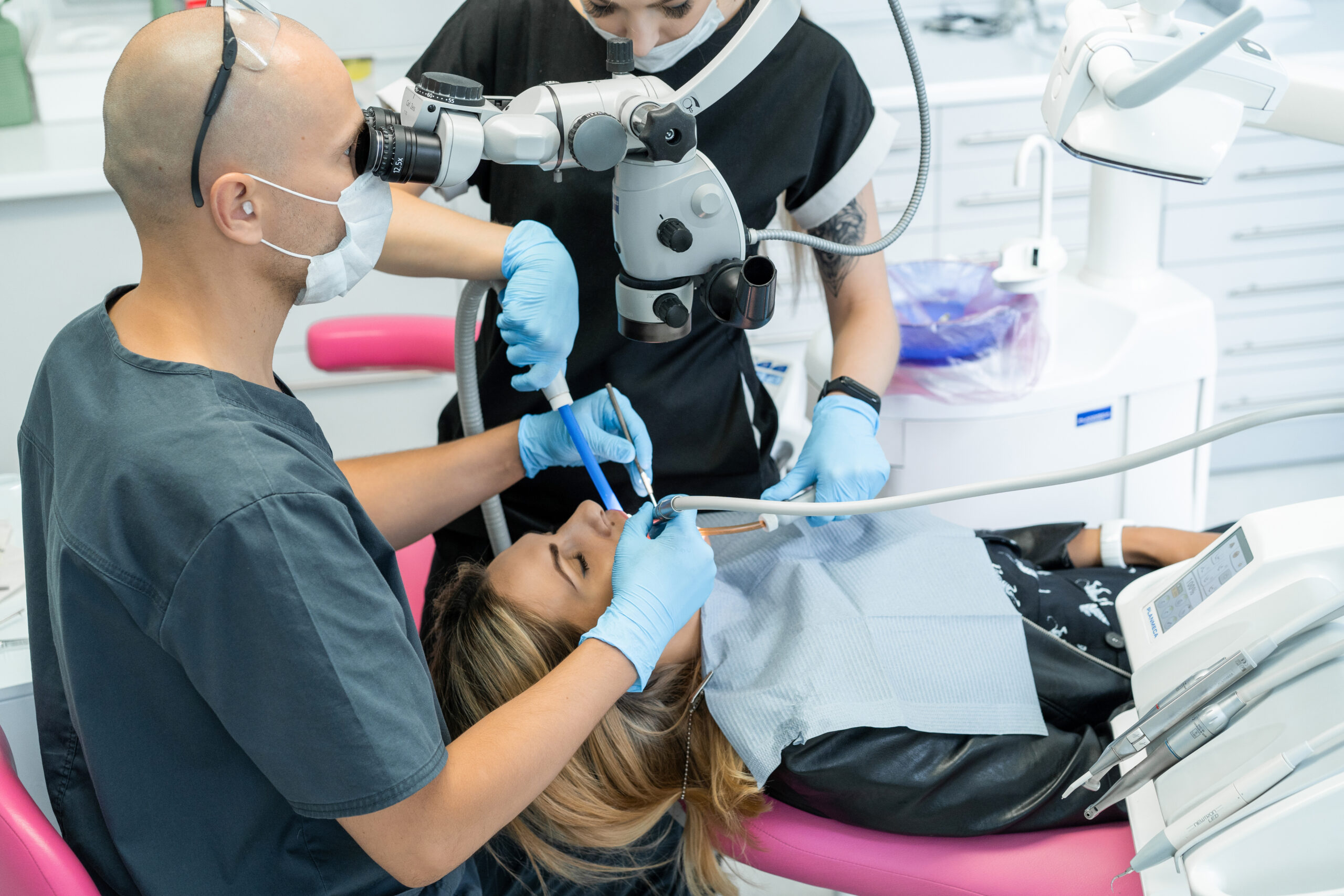When patients are asked about “the most unpleasant sound at the dentist,” the drill almost always comes out on top.
Yet it’s often forgotten that the dental drill has been a lifesaver for teeth for decades. Without it, millions of teeth would have long been lost.
However, dentistry never stands still. Modern technologies such as ultrasound and lasers are opening up entirely new possibilities in endodontics—making treatments more precise, faster, and gentler. Here’s how these innovations complement—and may one day even replace—the traditional drill.
Why are root canals such a challenge for dentists?
A tooth root is not a “straight tunnel” but more like a complex cave system. In addition to the main canal, there are tiny side canals, fine branches, and microscopic hidden pathways where bacteria can survive.
What consequences can hidden bacteria in the root cause?
- Occasional reinfections despite good treatment,
- Sometimes chronic discomfort due to residual bacteria,
- In the worst case: retreatment or tooth loss.
How painful is a root canal treatment really?
Many people immediately imagine scenes from the 1980s or 1990s when they hear “root canal”: long sessions, unreliable anesthesia, pain, and swollen cheeks. No wonder it makes patients nervous.
Today, however, the reality is much calmer and more professional. Modern root canal treatments use precise anesthesia techniques, including sedation, making procedures virtually painless.
Materials, instruments, and disinfection methods have also improved dramatically.
A modern root canal treatment primarily means preserving teeth at the highest level with minimal discomfort. The days of fearing pain and lengthy procedures are behind us.
The next generation of root canal treatment: precision with lasers and sonic waves
New technologies such as lasers and ultrasonic devices are expanding the scope of endodontics.
They do not yet replace the drill but complement traditional methods where conventional tools reach their limits:
- in the tiniest canals,
- with stubborn biofilms,
- and for patients who could benefit from an even gentler approach.
Recent studies (Nature, 2024; BMC Oral Health, 2025; PMC, 2025) indicate that lasers and ultrasound are more than just a trend—they are already considered a future standard in many professional circles.
Laser in root canal treatment
Root canal treatment, or endodontics, goes deep into the tooth to remove infection and often preserve the tooth long-term. Modern lasers have revolutionized this procedure, as they work with exceptional precision and efficiency.
A thin fiber optic delivers concentrated laser light directly into the root canal, reaching even the finest structures such as dentinal tubules, which are difficult to access with traditional irrigating solutions.
Laser energy is highly antibacterial, destroying bacteria and biofilms where germs often hide.
Advantages according to studies (Bach, 2014; Hülsmann & Schäfer, 2019):
- Sterilization of hard-to-reach areas (up to 1,100 µm),
- Gentle, non-contact procedure,
- Often fewer post-treatment complications,
- Better conditions for stable healing.
In practice, this means that lasers can make certain treatments even more effective.
Ultrasound in root canal treatment
Another advancement in endodontics is ultrasonically assisted irrigation, also known as Passive Ultrasonic Irrigation (PUI). It builds on traditional irrigation but makes it more effective.
A very fine instrument is inserted into the root canal and vibrates at high frequency. These vibrations move the irrigating solution, creating micro-currents and cavitation effects. Tiny gas bubbles form and burst, mechanically disrupting bacteria and biofilms, while transporting the solution into the smallest side canals.
Key benefits according to current research (MDPI, 2025; BMC Oral Health, 2025):
- Effective cleaning of even the finest dentinal tubules and side canals,
- Mechanical disruption of biofilms that protect bacteria,
- Better penetration of the solution into hard-to-reach areas,
- Complements traditional irrigation and increases the success rate of root canal treatments.
Why “classic” and “high-tech” are not contradictory
Lasers and ultrasound are extensions of classical methods and are gradually entering daily practice.
- The drill remains a reliable tool for your dental health for the time being.
- Lasers and ultrasound step in where traditional instruments and irrigants reach their limits.
This synergy makes treatments safer, more precise, and more comfortable overall.
How to avoid a root canal treatment
To prevent the need for a root canal in the first place:
- Regular dental hygiene/prophylaxis removes plaque and bacteria early.
- Preventive check-ups in our LifeDent clinics in Lucerne, Volketswil, Bülach, Winterthur, or Neukirch can detect problems early before infections occur.
These measures help maintain your dental health long-term and significantly reduce the risk of root canal treatment.
Endodontics 2030: Where we’re headed
Current studies (BMC Oral Health, 2025; PMC, 2025) show that laser and ultrasonic technologies improve cleaning quality and stabilize long-term results. But this is just the beginning. Research is currently focusing on three exciting developments:
- Artificial Intelligence (AI) – Could adjust laser settings in real-time based on tooth structure and infection status.
- Smart ultrasonic devices – Systems that automatically adapt vibrations to the individual canal geometry.
- New materials – Bioceramic sealers with antibacterial properties for long-term, tight seals.
Conclusion: Proven + Innovation = Future
Today, classical root canal treatment with the drill reliably saves teeth—and it will continue to do so. At the same time, research shows that laser and ultrasonic endodontics have the potential to eventually replace the drill.
For you, this means: you can rely on safe, proven root canal treatments, while looking forward to the careful integration of new technologies like lasers and ultrasound, used whenever they bring real benefits to your dental health.

